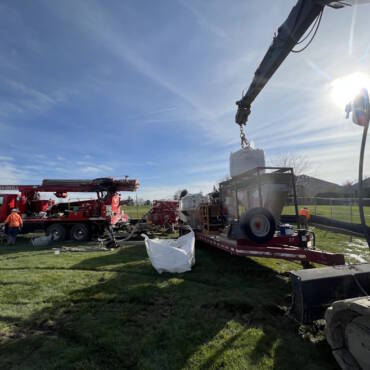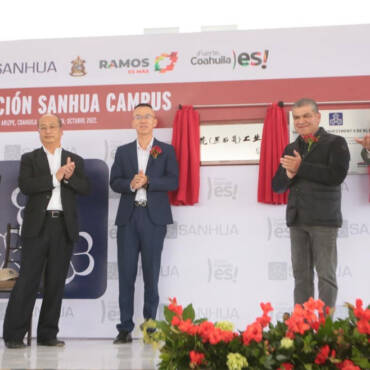✕
Per the AIM Act, starting January 1, 2025, most new comfort cooling systems are required to use lower-GWP refrigerants like R-32 or R-454B, which are classified as mildly flammable (A2L). Due to this flammability level, safety features, including refrigerant detection systems (RDSs), must be integrated into new split systems, in compliance with UL safety standard 60335-2-40.
An RDS identifies specific refrigerants when they reach set concentration levels and activates safety measures if these levels are exceeded. Typically, this involves turning on the blower, which disperses refrigerant vapor until the sensor no longer detects a leak. RDSs are generally required in A2L systems with refrigerant charges exceeding 4 pounds (64 ounces) and may be installed in the field or in the factory, depending on the manufacturer. As described below, manufacturers are offering a variety of resources and guidelines to ensure technicians have all the information they need regarding RDSs.
Bosch
To support their partners as they navigate the transition from R-410A to the new R-454B refrigerant, Bosch has developed training focused on safety, installation, operation, and service for these new units, said Phil Rains, applications engineer and trainer at Bosch Home Comfort.
“Through ongoing in-person sessions and online webinars, we are addressing when and where an RDS is needed for air-source and water-source heat pumps,” he said. “Bosch is also paying close attention to evolving requirements for manufacturing and handling low-GWP refrigerants, and we’ll be continuing to announce new product updates throughout 2024 and 2025.”
Additionally, Bosch includes a dedicated section in each air-source heat pump’s installation, operation, and maintenance manual, which includes instructions for determining when and where an RDS is needed, according to the UL60335-2-40 standard. Contractors and technicians can quickly refer to these requirements when installing units onsite, noted Rains.
On all current Bosch air-source heat pumps, the RDS will be factory installed, regardless of R-454B refrigerant level. The sensor is positioned on the evaporator coil and connected to the control board of the unit. For Bosch IDS air-source heat pump air handlers, this means the factory-installed A2L sensor will be installed on the evaporator coil that directly connects to the indoor unit control board. All Bosch Climate 5000 mini-split ductless systems will include a factory-installed A2L sensor on the indoor unit evaporator coil that directly connects to the unit’s control board.
“Bosch water-source heat pumps that include more than 64 ounces of refrigerant will have a factory-installed leak detection sensor internally on the evaporator coil and connected to the unit controller,” said Rains. “The sensor is optional on all water-source heat pumps with less than 64 ounces of R-454B refrigerant and can be field installed if necessary.”
For third-party furnaces and legacy Bosch furnaces that were designed for use with R-410A coils, Bosch will offer a Refrigerant Sensor Adaptor Box, said Rains. “With a new or existing furnace, there will be a cased coil attached to the furnace with an evaporator coil inside. Bosch cased coils will include a factory-installed A2L sensor on the evaporator coil that directly connects to the control board of the Bosch Rev C — our R-454B furnace. Use of the field-installed A2L accessory kit will enable communication of leak detection. This will start up the blower of the third-party furnace and shut down the compressor of the condenser, as well as the burner of the furnace.”
Looking for a reprint of this article?
From high-res PDFs to custom plaques, order your copy today!
The lifetime of the Bosch RDS sensor is roughly 15 years for air- and water-source heat pumps. When the sensor is due for replacement, Rains noted that there will be a fault code and/or a blinking LED light displayed on the unit.
Carrier
Carrier has taken a multi-pronged approach to RDS training, said Matt Vargo, residential strategic product manager at Carrier.
“We have online training, in-person training, printed launch kits, training webinars, an online launch page with a wealth of resources, and we have trained the Product Management and Sales teams to be able to handle any type of questions regarding our RDS.”
Carrier’s RDS consists of two primary components — a refrigerant sensor and a control board — and all the company’s fan coil and ductless products will have the RDS factory installed. Vargo said the furnace coils are a little trickier, since the control cannot be located in the wet environment of the coil.
“For that product, the sensor is factory installed, and all the necessary components for the rest of the system are shipped in a box within the coil to be installed in the field,” said Vargo. “This means that regardless of which product is being ordered, our dealers will have all the necessary RDS components without the need to order additional kits.”
Because refrigerant is heavier than air, Vargo explained that all of Carrier’s sensors will be placed low on the indoor coil, and this placement will remain consistent across commercial, residential, and multi-family equipment.
“The exact location on the coil will be based on that coil’s design to ensure that the sensor is in an optimal location for refrigerant detection,” he said. “The only reason that the sensor would be in a different location than low on the coil would be for horizontal applications of multi-poise equipment. In that situation, the sensor will need to be moved to a predetermined mounting location that is clearly marked for the field.”
Carrier coils are compatible with any furnace, because its RDS is designed to intercept the thermostat signal before it goes to the furnace and change it based on the needs of the system, said Vargo.
“During dissipation, the control will disable the active call and replace it with a call for constant fan,” he said. “This means that the furnace is not ‘aware’ of the dissipation mode and is simply responding to a new thermostat input. This allows our coils to be used on any furnace, making installation much easier. The only change that needs to be made is that the thermostat first needs to be connected to the dissipation control, and then the control needs to be connected to the furnace. Here again, we are focused on making this easy for the dealer by having all the connections made at the furnace where we would normally have them. In addition, all of the wires are clearly marked and color-coded for easy identification.”
On properly installed Carrier equipment, the RDS is designed to last the full life of the product, negating any need for regular or preventive maintenance, noted Vargo. In the event that the sensor was to fail, he said that it is available as a replacement component that can be easily ordered.
“If at any time the sensor stops working, the control will enter a fault sequence where the error is being displayed on the control and sent to any dealers that are connected to our equipment via the cloud.”
Daikin
Daikin is educating dealers about its RDS through product announcements, technical bulletins, training, installation and operation manuals, service manuals, and dealer meetings, said Josh Barr, director of technical services at Daikin Comfort Technologies North America Inc. He added that Daikin’s RDS can be factory or field-installed.
“Our new Daikin, Goodman, and Amana brand furnaces and air handlers engineered for R-32 systems include factory-installed RDSs,” said Barr. “We also have a Furnace Integration Kit for R-32 systems that are field installed, to provide RDS for furnaces and modular air handlers engineered for current R-410A systems that do not have a factory-installed RDS compliant control board.”
Once installed and operational on existing Daikin, Goodman, and Amana brand furnaces, the Furnace Integration Kit provides the mitigation protocol if a leak of R-32 refrigerant is detected in the evaporator coil, including third-party R-32 coils equipped with R-32 leak detection sensors, added Barr.
Daikin’s new R-32-compliant furnaces have a factory-installed RDS control board in the blower section of the furnace, with the sensor located near the evaporator coil, said Barr. The R-32 sensor cable from the evaporator coil is routed into the furnace blower section and plugged into the new RDS control board. In air handlers, the factory-installed RDS control board is in the blower section with the sensor located near the evaporator coil.
The RDS control and sensor are expected to last the life of the Daikin equipment in which they are installed. Barr stated that no maintenance of the RDS controller or sensor is required, and both the RDS controller and sensor can be replaced in the field. The RDS control board also includes error codes to help with troubleshooting diagnostics. The operating temperature range of the sensor is -40℉ to 175℉, and the sensor is IP53 approved, so there is no concern with condensation getting on the sensor, he said.
When installing an A2L system, technicians should read the installation and operations manuals provided, follow the instructions, and use proper installation procedures, said Barr.
“Make sure indoor and outdoor equipment is properly wired and grounded,” he said. “During installation and commissioning, verify proper airflow, check for leaks, and test the RDS system operation in heating, cooling, and continuous fan modes to confirm the entire system is properly installed, and the RDS is working correctly.”
Johnson Controls
The goal at Johnson Controls is to make the transition to low-GWP equipment as seamless and confusion-free as possible for contractors and distributors, said Ketan Namjoshi, product manager of residential controls and digital solutions at Johnson Controls Residential and Light Commercial, so they can focus less on calculations and conversions and more on providing comfortable, efficient, safe, and compliant installations. That is why, in September 2024, Johnson Controls launched an industry-first Refrigerant Detection System (RDS) Calculator within the Ducted Systems Solutions (DS Solutions) mobile app, he said.
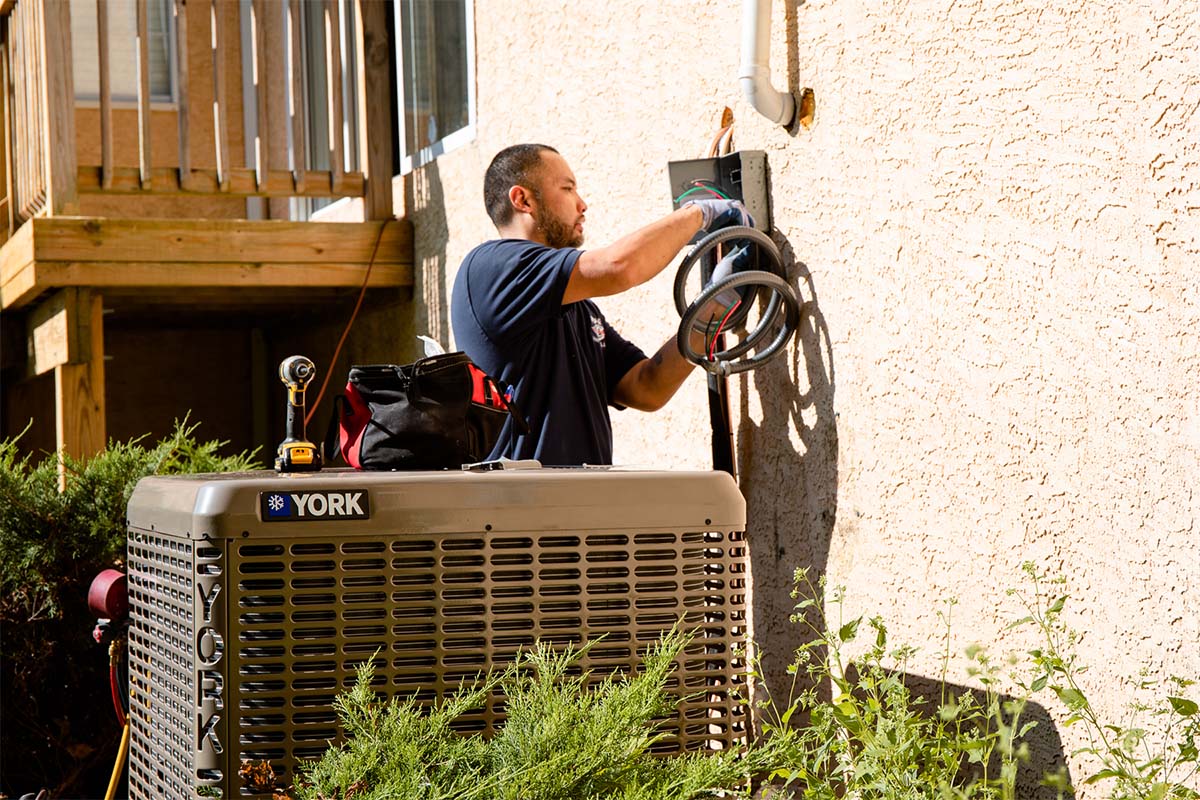
SEAMLESS TRANSITION: The goal at Johnson Controls is to make the transition to low-GWP equipment as seamless as possible for contractors. (Courtesy of Johnson Controls)
“The RDS Calculator determines when packaged commercial and residential products using R-454B refrigerant require a refrigerant leak detection system per standard UL/CSA-60335-2-40, based on actual building applications,” said Namjoshi. “This tool considers the refrigerant volume, supply air discharge height, total area being conditioned, and potential ignition sources to determine if an RDS is required. It will also determine if exhaust air is required in the conditioned space. The user-friendly calculator gives straightforward recommendations in just a few, simple steps.”
In addition, Johnson Controls offers online in-depth public resources and ongoing webinars, as well as in-person training at its Ducted Systems Academy. These programs cover the low-GWP refrigerant transition, including new A2L equipment and RDS familiarization training.
New R-454B equipment from Johnson Controls with refrigerant charge in the largest circuit under 4 lbs. will not require an RDS sensor, while units with charge over 34 lbs. in the largest circuit will have an RDS sensor factory installed. For units with a charge between 4 and 34 lbs. in the largest circuit, some products will come with a factory-installed sensor, while others can be field installed.
“This will depend on factors such as product type, heat source, area requirements, supply air discharge height, total conditioned area, potential zone impact, and ignition sources,” said Namjoshi. “For A2L units without factory-installed sensors, field-installed accessories specifically designed and tested for their specific equipment will be available. We will also offer field service kits for sensor replacements.”
The general location of the sensor within the unit will not change depending on the type of application, said Namjoshi. For example, in residential units and commercial rooftop units (RTUs) from Johnson Controls, the RDS sensor will be located in the air stream near the evaporator coil.
“In larger RTUs with bigger evaporator coils, multiple sensors may be used to monitor for leaks across the entire face area of the coil,” he said. “The sensor(s) are in the air stream flowing directly across the evaporator coil, and the RDS is wired into the unit’s main control board or mitigation board, depending on the unit type.”
Both commercial and residential RDS sensors should last the expected life of the unit, said Namjoshi, and they have mandatory, built-in self-diagnostics, which will let the technician know if a sensor has failed via an error signal. If the sensor should fail, technicians can replace it in the field; however, Namjoshi noted that they must be sourced from the OEM that manufactured the unit, as the sensor and its controllers are specifically approved by a nationally recognized safety agency for each specific product.
Lennox
Lennox offers comprehensive educational resources about RDS kits through multiple platforms that utilize subject matter experts and industry professionals, said Doug Smiley, technical training manager at Lennox Residential HVAC.
“These resources include webinars, instructor-led videos, and presentations. Dealers can access all of these materials through LennoxPros.com and the Lennox Learning Center. Lennox field technical consultants also serve as a valuable resource, providing dealers with up-to-date information and guidance, alongside Lennox Learning Solutions for extended training so that all involved are knowledgeable about low-GWP refrigerant.”
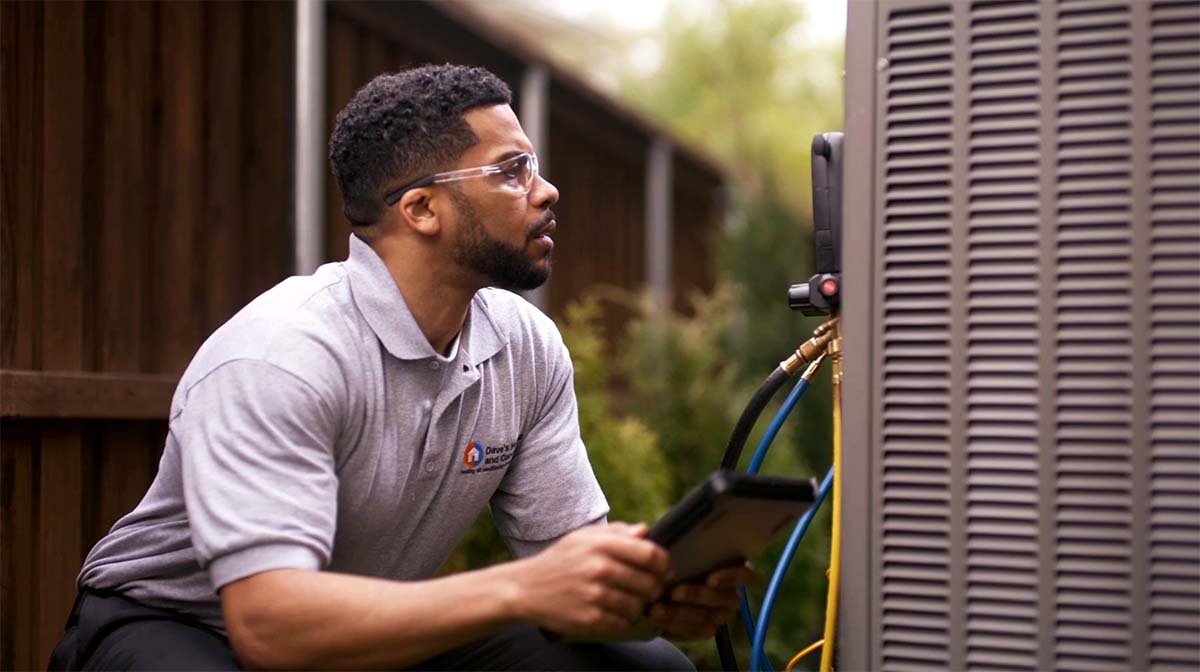
STAY INFORMED: Lennox is providing ongoing support and educational resources to help technicians stay informed about low-GWP systems. (Courtesy of Lennox)
At Lennox, RDSs may be installed either in the factory or the field. For example, on Lennox -71 coils and air handlers, RDSs are factory installed, said Smiley, while on -01 coils and air handlers, RDS kits are separate and field installed on the evaporator coil.
“For Lennox Residential products, the sensor is always installed at the evaporator coil,” said Smiley. “For Lennox Commercial products, each rooftop unit has a specific spot for its RDS placement, with some units requiring one sensor and some requiring two. Some are by the compressor, and some are by the evaporator coil.”
When it comes to installing A2L equipment with an existing furnace, very few modifications must be made, said Smiley, except when installing the appropriate blower control board (communicating or non-communicating) for the system to function with the new refrigerants.
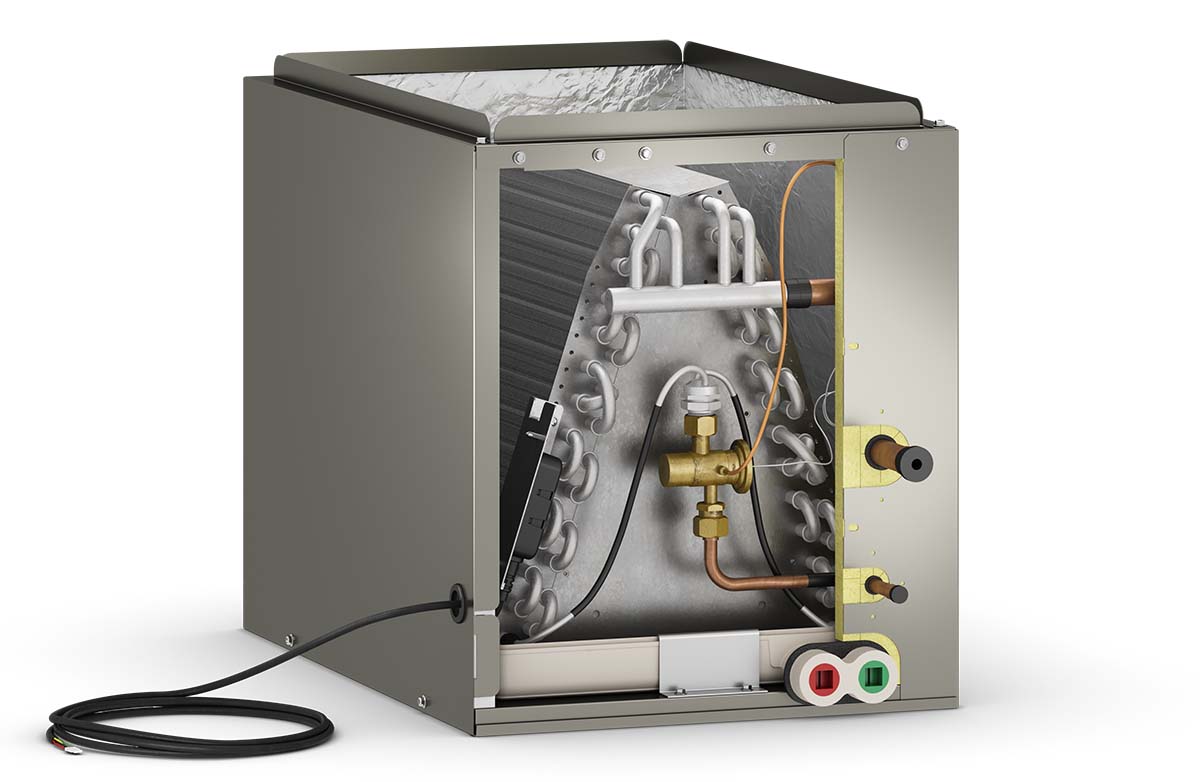
UPFLOW COIL: An upflow coil from Lennox is shown with a factory-installed RDS. (Courtesy of Lennox)
“In the first half of 2025, Lennox will introduce our new lineup of gas furnaces that will have these controls factory installed.”
The Lennox RDS kits do not require regular maintenance; however, if a technician follows proper diagnostic procedures and identifies that the RDS is not functioning as expected, it should be replaced, said Smiley.
NGH
NGH is aware that the new refrigerant and associated components might be intimidating for some contractors, so the company made a concerted effort to educate them as much as possible using a variety of methods, said Dan Ayres, product manager at NGH. He added that one of the more impactful resources the company provides is the Lunch & Learn videos on their YouTube page.
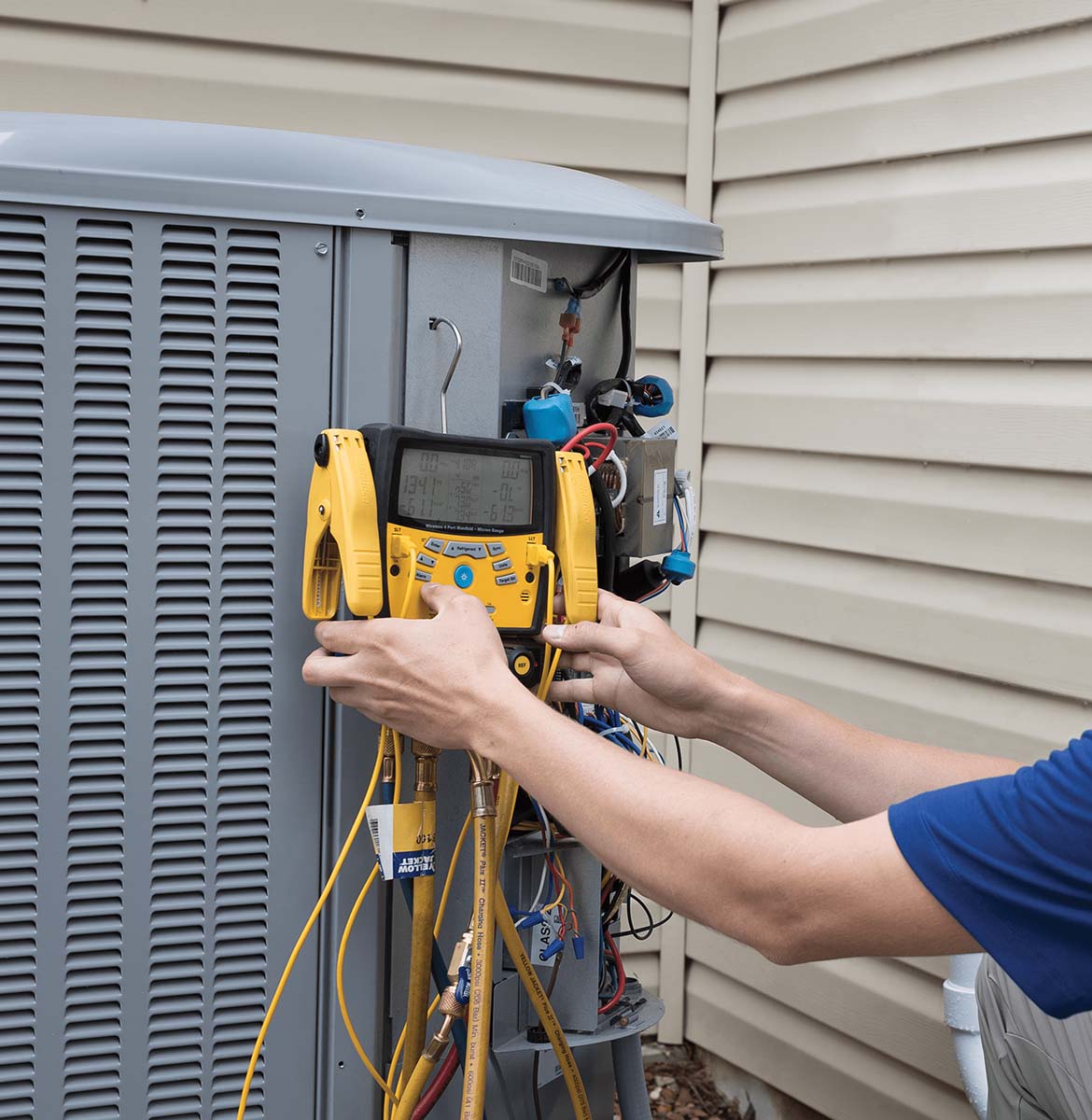
EDUCATING CONTRACTORS: NGH has made a concerted effort to educate contractors about the refrigerant transition as much as possible, using a variety of methods. (Courtesy of NGH)
“The Lunch & Learns provide us an opportunity to deliver a great deal of information in one video and allows technicians the ability to go back and review the content as needed,” said Ayres. “Our first round was released in the Spring, where we discussed several topics ranging from how we came to our RDS solution, to how the new refrigerant will impact installation. We were even able to bring in our friends at Copeland to do a deep dive on the inner workings of the new refrigerant, so there’s a lot of good content available. Our customers found so much value in the early videos, we decided to do a second round, which launched earlier this month. We’re focusing more on the actual installation and wiring of our sensor in the latest round, so I’m sure technicians will find a lot of value in those videos as well.”
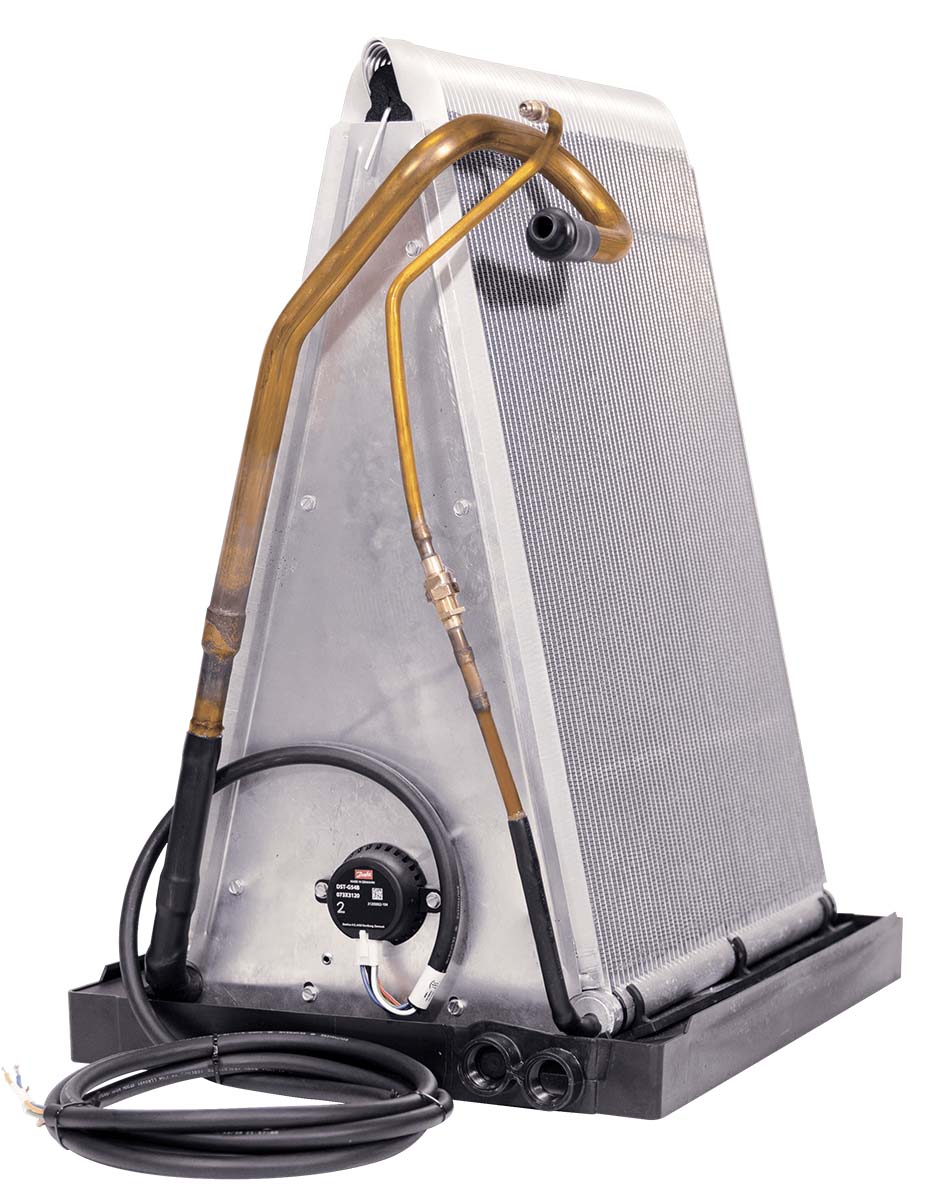
FACTORY INSTALLED: NGH’s RDS is factory installed on the delta plate for both its cased coils and air handlers. (Courtesy of NGH)
NGH’s RDS is factory installed on the delta plate for both its cased coils and air handlers, said Ayres. “We were focused on minimizing the impact to technicians as much as possible, and we feel our solution is one of the easiest solutions to install, while still providing the highest level of safety available.”
In an effort to minimize SKU changeover as much as possible, NGH made sure its RDS solution did not require a change to the furnace.
“Our solution operates between the thermostat and the air mover, so a few simple wire connections mean we can engage any necessary mitigation activity without the need for special blower boards or external equipment,” said Ayres.
The RDS on NGH equipment has a projected life of at least 15 years, noted Ayres.
“Another great thing about our solution is it’s basically maintenance-free. There are LEDs on the sensor to inform the technician what the sensor is reading, and, in the unlikely event the sensor fails, it ‘fails safe,’ which means it locks out the system and lets the homeowner know it’s time for a service call without introducing an unmitigated hazard.”

GETTING COMFORTABLE: Once they work with the new A2L systems, NGH believes contractors will see that they are not that much different than the components and processes they currently use. (Courtesy of NGH)
Rheem
Rheem is committed to ensuring that its dealers and contractors are well-prepared to handle the evolving refrigerant landscape, which is why the company has introduced two comprehensive training presentations focused on key aspects of A2L refrigerants, said Jose De La Portilla, senior manager of education and training at Rheem.
“The first training, ‘A2L Steps to Success,’ covers the basics of A2L refrigerants, including safety protocols, transportation, handling, and best practices for installation and service,” he said. “The second section, focused specifically on RDSs, provides detailed guidance on regulations that mandate A2L sensors, the different types of sensors available, proper sensor installation techniques, and troubleshooting tips. Through these presentations, Rheem provides contractors with the knowledge and tools to determine when and where an RDS is needed, ensuring safety and compliance on our ducted A2L systems.”
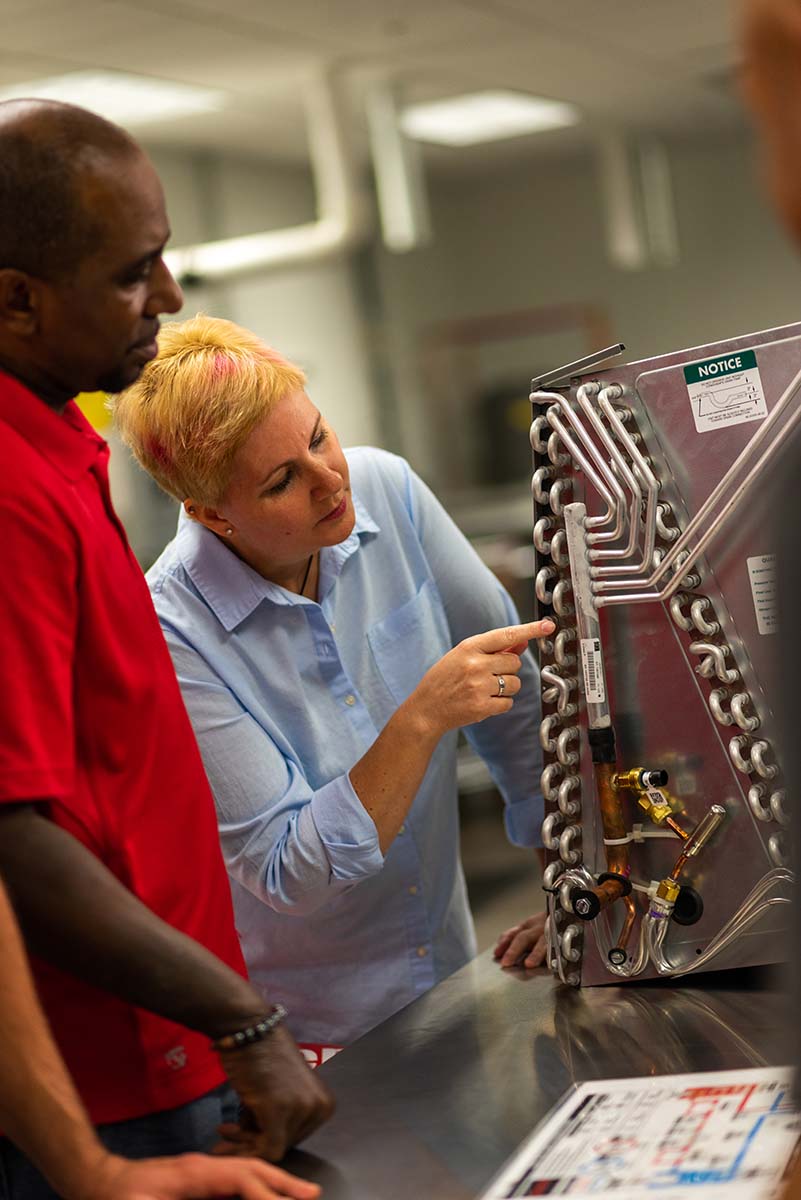
FACTORY OR FIELD: Rheem’s RDS can be factory or field-installed, depending on the unit and application. (Courtesy of Rheem)
Rheem’s RDS can be factory or field-installed, depending on the unit and application. Factory-installed sensors typically come shipped for upflow installations, said De La Portilla, but for horizontal or downflow installations, a field conversion is required. For residential air handlers and coils, he noted that units can be sold either with or without factory-installed sensors, while Resipack and commercial units always come with sensors factory-installed.
“If installing sensors in the field, Rheem provides kit options, which are often model-specific and include the necessary components: sensor, wires, wiring harness, bracket, and installation instructions,” said De La Portilla. “For field installation of sensors on coils or air handlers, it’s important to check the orientation (upflow, downflow, horizontal), install the sensor on the bracket according to the applicable orientation, and ensure proper wiring following the installation instructions and wiring diagrams. For applications with cased coils or PSC air handlers, a relay will also need to be installed. These kits are designed specifically for Rheem equipment, ensuring seamless integration and optimal performance.”
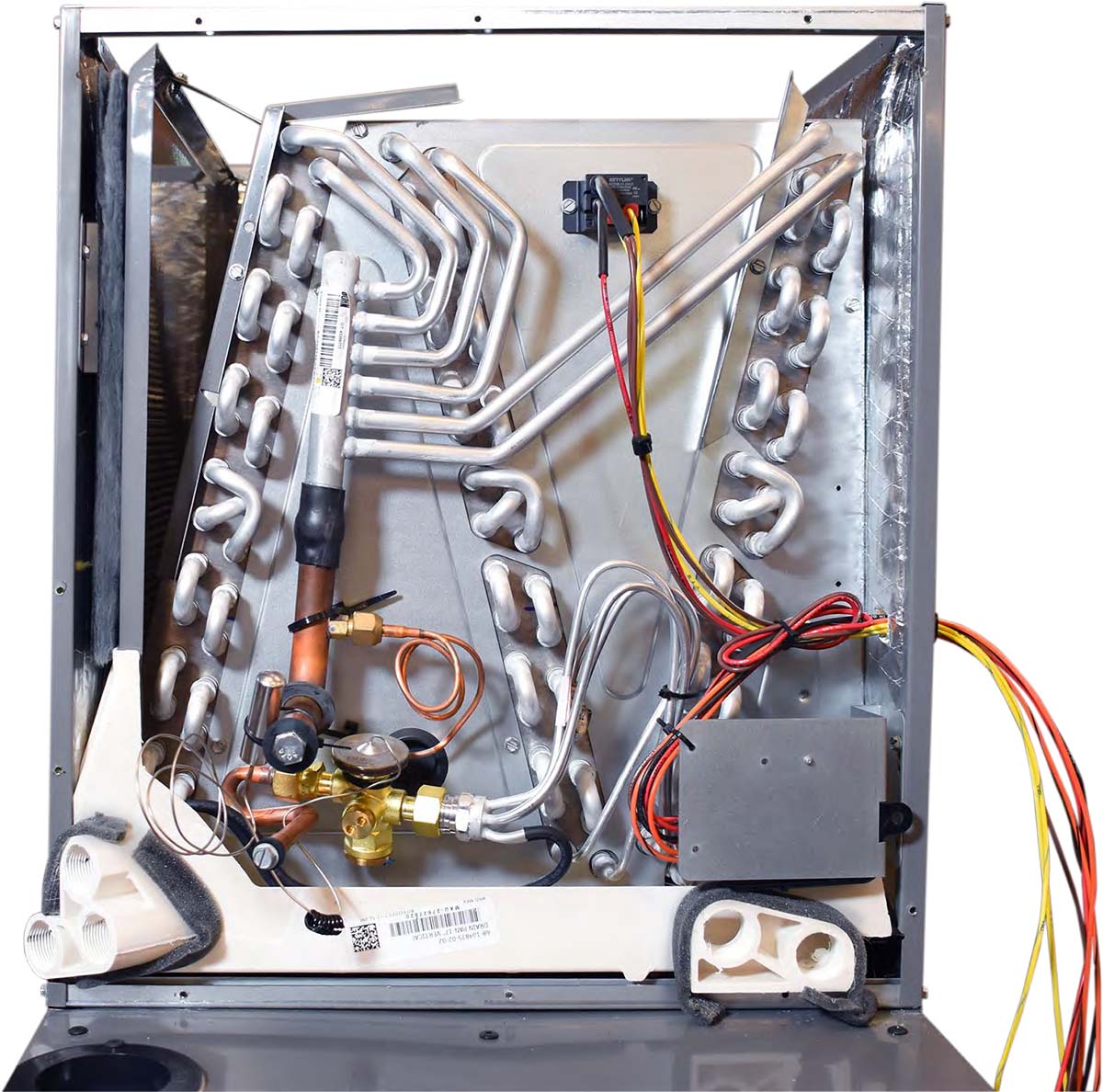
SENSOR PLACEMENT: The RDS sensor must always be placed in the lowest part of the indoor coil to detect pooling refrigerant. (Courtesy of Rheem)
While the RDS sensor must always be placed in the lowest part of the indoor coil to detect any pooling refrigerant, the exact location will differ due to variations in cabinet design between residential and commercial products, said De La Portilla.
“This ensures the sensor is optimally positioned to sense refrigerant accurately in each type of application.”
When installing an A2L system with an existing furnace, De La Portilla noted that technicians should be aware of the following key considerations to ensure proper integration and safety:
- Ensure that the existing furnace is compatible with the A2L refrigerant system. A2L refrigerants require specific safety measures due to their mildly flammable nature, so it’s critical to follow Rheem’s guidelines for retrofitting or upgrading equipment.
- If the RDS is not factory installed, technicians will need to install the sensor kit (including sensor, wiring, harness, and bracket) according to the furnace’s orientation (upflow/downflow or horizontal) and wiring instructions. Attention to orientation and wiring is crucial for ensuring proper sensor functionality.
The RDS in Rheem’s systems is designed with an expected lifespan of around 10 years, although this can vary depending on maintenance frequency and the environmental conditions the system operates in, said De La Portilla.
“For example, exposure to corrosive environments may reduce the sensor’s lifespan. Technicians can replace the sensor in the field if needed, and replacement parts are readily available in our system for quick and efficient servicing.”
Trane
Trane has offered its dealers many resources on the upcoming refrigerant transition, said Sean Goddard, product manager for coils and indoor air quality at Trane Technologies.
“Specific to the RDS, we offer online and in-person trainings on the function and components of an RDS in detecting and mitigating refrigerant leaks,” he said. “In addition, we have hosted and continue to host product reviews to pair with marketing materials generated to help educate dealers in a simple and engaging method.”
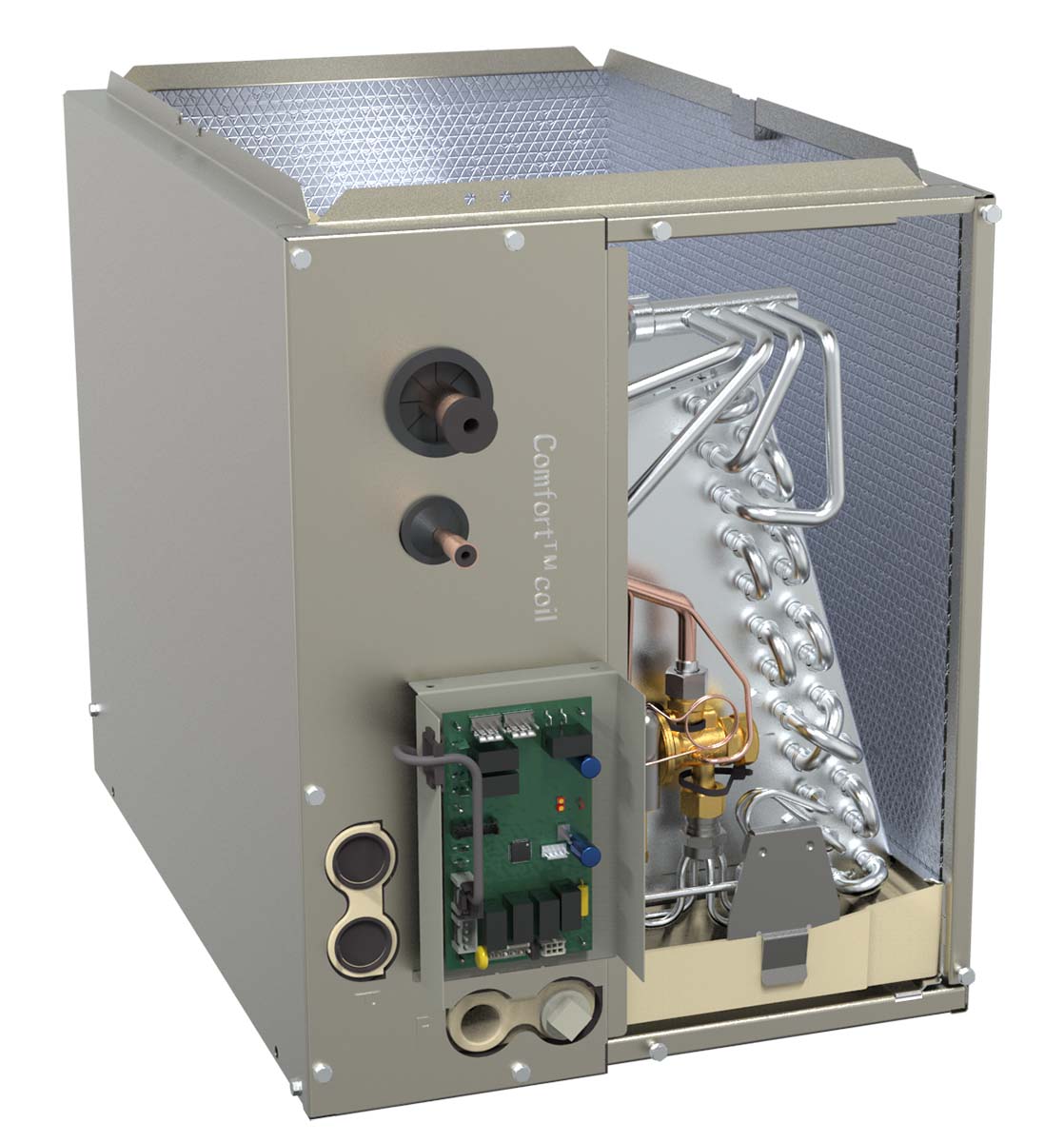
RDS PLACEMENT: The RDS is factory-installed on nearly all of Trane’s indoor equipment, including air handlers, cased coils, and packaged systems. (Courtesy of Trane)
The RDS is factory-installed on nearly all of Trane’s indoor equipment, including air handlers, cased coils, and packaged systems. This streamlines the work for technicians during the refrigerant transition, as it does not require any additional processes for installation, said Goddard.
“Using direct dealer feedback, we have developed A2L-specific equipment that simplifies the transition for technicians and installers. Our factory-installed solutions for RDS reduce changes required on a job site. And, A2L equipment can be installed with existing Trane furnaces, because there are no changes to furnace equipment for the transition.”
On Trane’s residential equipment, the leak detection sensor is installed near the drain pan of the indoor coil, because in the event of a leak, refrigerant will sink to the lowest point in the system.
“For split air handlers and cased coils that can be installed in multiple orientations, the sensor is factory configured in upflow orientation, but for other orientations, the sensor can be easily relocated to ensure it is at the lowest point,” said Goddard. “The mitigation control board (MCB) can be found on the exterior of the coil, while for split air handlers, the MCB is located next to the existing controls. There are more details on installation guidelines in the installer’s guide that is shipped with the unit.”
Trane’s RDS should last the duration of the unit’s life, or approximately 10 years, and requires no regular maintenance, noted Goddard.
“In the event of a sensor failure, the RDS will default to mitigation mode,” he said. “If using a communicating system, the system may be able to identify the issue and provide details on the alert.”
Whether you require installation, repair, or maintenance, our technicians will assist you with top-quality service at any time of the day or night. Take comfort in knowing your indoor air quality is the best it can be with MOE heating & cooling services Ontario's solution for heating, air conditioning, and ventilation that’s cooler than the rest.
Contact us to schedule a visit. Our qualified team of technicians, are always ready to help you and guide you for heating and cooling issues. Weather you want to replace an old furnace or install a brand new air conditioner, we are here to help you. Our main office is at Kitchener but we can service most of Ontario's cities
Source link

